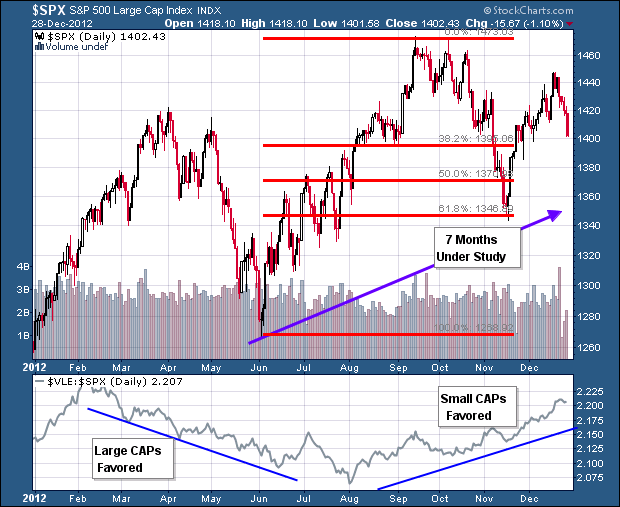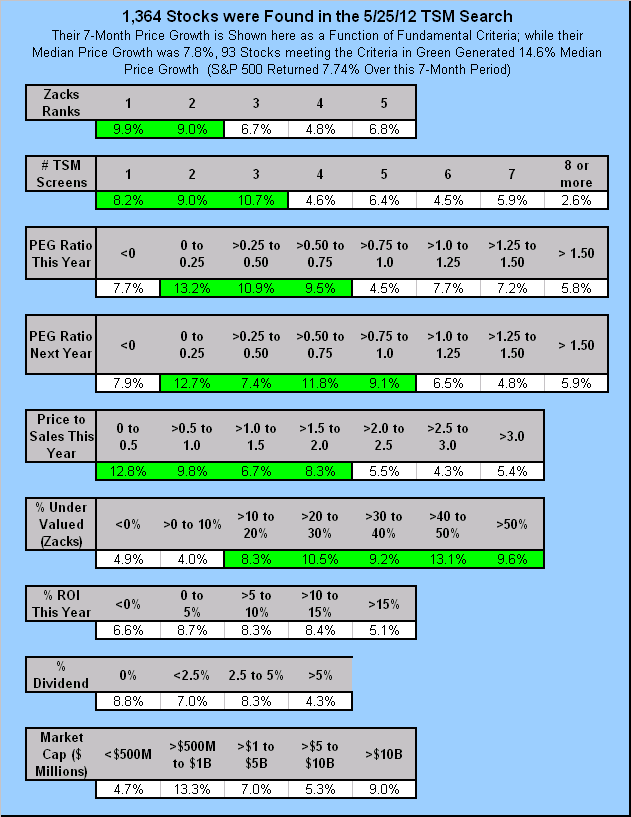While most of my trading has been short term--averaging about six days in
the trade--I insist on trading fundamentally sound stocks, as opposed to
just any old stock making a pullback. Why? The answer is simple:
I like the safety net formed by institutions that want to buy fundamentally
sound stocks. They are always there ready to step up and buy when
these stocks pull back to their areas of support.
But
fundamentally sound stocks are not enough, as the best stock in the world
can be overpriced. One needs metrics that address value as well, i.e.,
that assures you that the stock's current price has room to grow.
PEG ratios (Current Price / Annual Earnings / Earnings Growth or PE Ratio /
Annual Earnings Growth) fill that
need for me. As described in this article,
the TSM PEG ratios are forecast for just the next two years, not the
five-year growth estimates commonly used. I believe that analysts are
good at doing one thing well: valuing a company's earnings over the
next two years. And these valuations are enough to estimate a stock's
remaining value. The smaller this two-year PEG ratio, the lower its PE ratio
is relative to its earnings growth and the better the value.
TSM Rankings
The TSM ranking is a composite of several factors important to a stock's
longer-term price growth, say over the next six months. This ranking is
important both because of the underlying institutional interest in these
type stocks and because TSM's naked put and married put strategies are both
longer-term strategies (from one to six months) designed to generate a good
return on investment capital.
Consider the following chart of the S&P 500 taken over the past year.
In particular, concentrate on the past seven months where the S&P has risen
to a 52 week high then pulled back to its 61.8% Fibonacci level of support
before rebounding. Note, as indicated by the $VLE:$SPX relationship
(ratio of Value Line 1700 stocks versus the S&P or small caps relative to
large caps), the region began with large cap stocks being favored but then
spent most of the period with an increasing preference for smaller caps.

If one looked at the median price growth of the 1,364 TSM stocks generated on 5/5/12
from its proprietary screens, over
the next 7 months--a period where the S&P gained 7.74%--several fundamental metrics impacted
these stock's price growth.
-
Zacks Rankings of 1 and 2 are the best of the best based
on Zacks proprietary rankings which are ranked according to several
earnings criteria;
-
Membership in 3 or fewer TSM screens outperformed;
membership in a few screens identified those stocks new to these
screens, those just beginning to outperform in terms of their
fundamentals;
-
Two year PEG ratios, as described above, the lower the
better so long as they are positive;
-
This year's price-to-sales ratio similarly identified
those stocks which were priced low relative to their sales--again, the
lower the ratio the better the value;
-
Finally, the more undervalued the stock--according to
Zacks discounted cash flow model--the better the performance.
These metrics will form the basis for TSM's 1 to 6 ranking
(one point for meeting each of these six metrics in the green areas).
On the other hand, market cap, % dividend and % return on investment had
little impact on the 7-month price growth. Just 93 of the 1,364 stocks
met all the criteria in green. Their median price growth was 14.6%.
Obviously, the longer the trade period, the more important these metrics
are, i.e., the greater the TSM ranking the better the expected performance
over the next six months or so.
